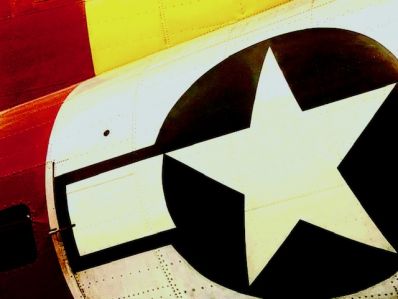Lest we forget: London's wartime legacy
2025 is the 80th anniversary of the end of the Second World War and, in a guest blog, Mr Londoner reflects on its legacy and explores what can still be seen today from London's wartime past.
 The gathering storm. Churchill's statue surveys the Palace of Westminster @meetmrlondoner
The gathering storm. Churchill's statue surveys the Palace of Westminster @meetmrlondoner
In 2024, we witnessed the moving spectacle of some of the very last Second World War veterans paying their respects to those who fell on the beaches of Normandy, during the D-Day Landings. In 2025, we mark the 80th anniversary of the end the war itself. This will be a time for reflection and of poignancy - as conflict still rages across the globe. Nevertheless, the anniversary will attract UK-bound visitors, especially those from the USA and the Commonwealth, perhaps tracing the steps of parents and grandparents.
The blitzed City
London and the UK’s major ports and cities suffered terribly during the Blitz. This aerial bombing claimed the lives of about 65,000 people across the country. What of this vivid, but desperate, story can still be seen in London today? A Blitz walk in the City of London is a good place to start. There are some telling reminders of the air war here. But you’ve really got to know where to look. The 1,000-bomber raids in 1940 and 1941 over this - our financial district - tore out its medieval and Victorian heart. And the bombing did not end with the Blitz - and the subsequent ‘Baby Blitz’ in 1944.
 The remains of Christ Church Greyfriars, destroyed in the Blitz @meetmrlondoner
The remains of Christ Church Greyfriars, destroyed in the Blitz @meetmrlondoner
The first rocket attacks (the terrifying V or vengeance weapons) rained down on London on 16 June 1944, just ten days after D-Day. They did so with devastating effect, claiming the lives of another 10,000 civilians. The rocket sites on the Dutch and German coast were eventually overrun by the allies as they marched toward Berlin, victory - and a new world order.
What lies beneath
Unexpectedly however, wartime destruction also revealed London’s Roman foundations, the Romans having founded Londinium in AD43. The archaeological discoveries attracted vast post-war crowds and these incredible remains can be seen to this day. The outline of the Roman fort can be clearly seen at Noble Street, in the City’s north-west corner. Nearby is the shell of a blitzed house. It’s remarkable that these ruins still stand, given the City of London houses the UK’s dearest real estate. These remains are testament the 6,000 lives lost in the City of London Blitz alone.
 Winston Churchill surveys bomb damage in London's East End in 1941
Winston Churchill surveys bomb damage in London's East End in 1941
St Paul’s Cathedral is London’s church. As every taxi driver will tell you, it stands at 365 feet tall - one foot for every day of the year. Built by Sir Christopher Wren after the Great Fire of London of 1666, it defines the City skyline to this day. In the darkest hours of the Blitz, Winston Churchill ordered “St Paul’s must be saved”. A fire watch of church officials and parishioners guarded the Cathedral around the clock. The building was hit many times by both high-explosive and incendiary bombs, but was ultimately saved, just as Churchill ordered.
 Guests find a green space to stop for tea during Mr Londoner's blitz city tour @meetmrlondoner
Guests find a green space to stop for tea during Mr Londoner's blitz city tour @meetmrlondoner
The Cathedral’s badly-damaged eastern end was re-built as the American Chapel. Here we commemorate the 28,000 wartime US servicemen and women who died while based in the UK. A book of remembrance records their names and one page is turned, with great reverence, every day. Chicago-born Olympic winter sports champion Billy Fiske died in the Battle of Britain in 1940. He was the second American to perish in the Second World War. He is commemorated in the Cathedral’s crypt. A plaque was mounted on Churchill’s orders to record this American sacrifice, while the US still remained a neutral country. Its inscription reads: An American citizen who died that England might live. The US declared war on Germany and Japan in 1941,16 months after Fiske’s death, following the devastating 7 December attack on Pearl Harbor.
 Carve her name with pride. SOE agent Violette Szabo @ meetmrlondoner
Carve her name with pride. SOE agent Violette Szabo @ meetmrlondoner
Across London are some fascinating works of art commemorating leading wartime figures. Winston Churchill glowers over Parliament Square, as he surveys the Palace of Westminster and beyond. Wartime leaders including ‘Monty’ - Field Marshall Bernard Montgomery - stand vigil outside the Ministry of Defence. Most moving of all is the bust, on the riverbank at Lambeth, of Special Operations Agent Violette Szabo. She was executed by the Nazis at Ravensbrück concentration camp, aged just 23. She was awarded the George Cross posthumously. Her story is told in the 1958 film Carve Her Name with Pride.
Going underground?
The Churchill War Rooms are full of atmosphere. Their popularity, however, can sometimes render them crowded and claustrophobic. A calmer alternative is the Imperial War Museum. The building has its own dark history. This is the former Bedlam (or Bethlehem) mental hospital. Today it explores how war has affected ordinary people across the globe.
 Terrifying. A sniper's camouflage at the Imperial War Museum @meetmrlondoner
Terrifying. A sniper's camouflage at the Imperial War Museum @meetmrlondoner
There’s a 1940s Japanese Mitsubishi Zero fighter - re-discovered in the 1970s on a Pacific island. There’s a 1938 Chevrolet truck used by New Zealanders serving with the Long Range Desert Group (the forerunner of the SAS or Special Air Service). This incredible find was discovered, perfectly preserved in the sands of the Libyan desert, in the 1980s. It’s a dignified testament to the allied desert raiders who struck airfields during daring attacks deep behind enemy lines.
 The R1155 receiver of a Lancaster bomber, Imperial War Museum @meetmrlondoner
The R1155 receiver of a Lancaster bomber, Imperial War Museum @meetmrlondoner
The National Army Museum, in Chelsea, occupies part of the Royal Hospital site. This beautiful building, also created by Sir Christopher Wren, is where elderly military veterans live out the rest of the days as ‘Chelsea Pensioners’. You can often see them around town. They have a distinctive uniform of a Victorian-style scarlet top-coat, black trousers and elegant black peaked cap, called a ‘shako’. By tradition, taxi drivers never charge the Pensioners a fare. The National Army Museum itself tells the story of the British Army to the present day. Its star objects include the robes of Lawrence of Arabia, the enigmatic British officer who fought the Ottoman Empire during the First World War. Museum entry is free.
Reach for the skies
The RAF Museum in Colindale, in the North London suburbs, is also free. It’s a hidden gem and one often missed by visitors. That’s a pity. The collection is incredible. It includes 1940s allied aircraft, such as the huge American B17 ‘Flying Fortress’ and its British opposite number, the Avro Lancaster. There’s a massive Royal Air Force Sunderland flying boat that you can enter along a specially-constructed walkway.
 RAF Sunderland at the Royal Air Force Museum. Picture: Simon Woodfield
RAF Sunderland at the Royal Air Force Museum. Picture: Simon Woodfield
The museum occupies the site of an historic airbase. One of its hangars dates to the very dawn of aviation. It features aircraft from the Battle of Britain including Supermarine Spitfires and a Hawker Hurricane. They are displayed alongside the enemy planes they faced in combat, including the Focke-Wulf Fw 190.
 B-17 Flying Fortress bomber at the RAF Museum @meetmrlondoner
B-17 Flying Fortress bomber at the RAF Museum @meetmrlondoner
These displays are especially poignant. Britain and its vast empire had stood on the brink in 1940. Europe had fallen to the lightning Nazi attack (blitzkrieg). All the enemy had to do was deliver Operation Sea Lion - the invasion of the UK by sea and air. But first, they had to defeat the Royal Air Force. The Nazi Air Force (the Luftwaffe), which had demonstrated its awesome power in support of invading ground troops, proved less efficient operating over water and allied territory. The RAF, although outgunned and outnumbered, prevailed. The small number of Battle of Britain pilots became known as ‘The Few’. They comprised those from many nations, including: Poland, Czechoslovakia, Hungary, Canada, Australia, Ireland, South Africa and Rhodesia. There were seven Americans too. All of their stories are told powerfully here.
Cracking the code
Station X had many names. But the code-breakers who worked at Bletchley Park in the rural Buckinghamshire countryside referred to it simply as ‘BP’. Britain’s spy school was conveniently located. It sat on the so-called ‘Varsity’ railway line, linking London and the north to the university towns of Oxford and Cambridge. This was handy, as Bletchley’s stated aim was to recruit capable people, of the “professor type”. BP’s mainly civilian staff - many of them women - monitored German, Italian, Japanese and Russian coded intelligence (known as ultra). They cracked the Enigma codes, enabling them to listen in to naval intercepts and monitor German submarines. They were led by the brilliant Alan Turing. His story features in films including The Imitation Game and Enigma.
 The UK is full of wartime defences. Devon's Brownstone Battery is now a coastguard lookout @meetmrlondoner
The UK is full of wartime defences. Devon's Brownstone Battery is now a coastguard lookout @meetmrlondoner
Beyond London and the major sites, there are smaller but nevertheless powerful wartime reminders across the UK. Norfolk’s former RAF North Creek control tower has been transformed into an immaculate guest house. The beautiful Fens and East Anglia are littered with concrete tank traps and brick and concrete ‘pillboxes’ - built to house machine gun nests. Coastal paths in Devon and Cornwall are home to decaying gun batteries and pillboxes. Some have been re-purposed as coastguard observation posts. They speak of a time when invasion was a clear and present danger.
The cruel sea
HMS Belfast, a massive destroyer launched in 1938, was one of the largest ships in the wartime Royal Navy. This incredible vessel was nearly scrapped after hitting a mine in 1939. Re-armed and re-fitted, it took to the seas once again, escorting Artic convoys, which provided a lifeline to the Soviet Union. It took part in D-Day and later in the Korean War. Today it’s permanently moored on the banks of the Thames. The ship has nine decks to explore. You can climb below the waterline into the engine rooms. You can head up to the bridge to see where the ship’s officers co-ordinated battle plans. In between, are gunnery platforms, wireless rooms, stores, workshops, the sick bay and even the kitchens. These evocative spaces tell a vivid story of life on board during the darkest days of the 1940s - followed by the uncertain peace of the post-war years.
 HMS Belfast @meetmrlondoner
HMS Belfast @meetmrlondoner
Mr Londoner - aka Antony Robbins - is a former director of the Museum of London. In 1995 he was part of the British government team managing the 50th anniversary of VE and VJ Day.
If you or your group would like to discover London's wartime past on a tailor-made tour with Janet Redler Travel, please do contact our friendly team today.

































